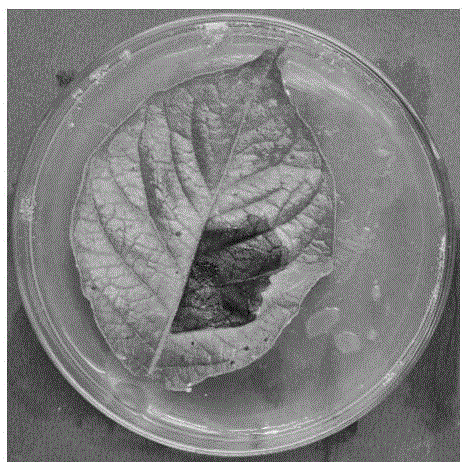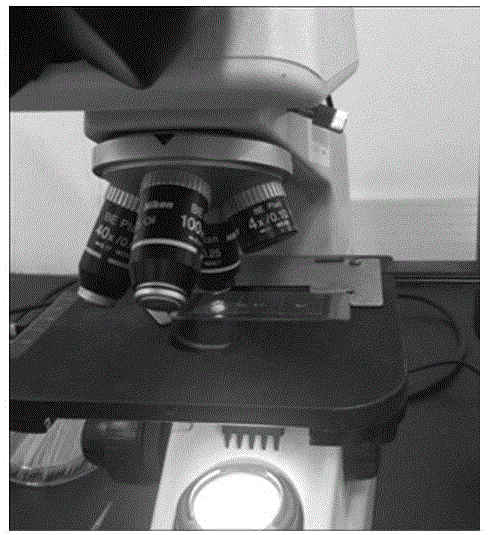Method for separating monosporangiums of potato late blight pathogens
A technology of potato late blight and monosporangium, applied in the field of microorganisms, can solve the problems of low success rate, time-consuming, difficult operation, etc., and achieve the effect of reducing time and improving operation efficiency
- Summary
- Abstract
- Description
- Claims
- Application Information
AI Technical Summary
Problems solved by technology
Method used
Image
Examples
Embodiment 1
[0020] (1) Pick a little mycelium from the diseased potato leaves with an inoculation needle, stir it several times in a 2ml centrifuge tube containing 200ul sterile water, and mix the mycelia and sporangia on the inoculation needle with sterile water, then use Vortex with a rotating speed of 1500rpm / min for 30s, repeat twice; then adjust the concentration of the sporangia suspension with a hemocytometer to adjust the concentration of the sporangia suspension to 1 / 2ul;
[0021] (2) Place three coverslips that have been sterilized with 75% ethanol on a glass slide, drop a drop of sporangia suspension on the three coverslips respectively, and then inspect under a 10×10 times microscope. To a single sporangia, add a 0.8cm×0.8cm rye culture medium on the droplet, then transfer it to a sterilized empty petri dish, and seal it;
[0022] (3) Put the petri dish in a refrigerator at 4°C for 3 hours at low temperature to stimulate the sporangia to release zoospores, then transfer to an ...
Embodiment 2
[0025] (1) Pick a little mycelium from the diseased potato leaves with an inoculation needle, stir it several times in a 2ml centrifuge tube containing 200ul sterile water, and mix the mycelia and sporangia on the inoculation needle with sterile water, then use Vortex with a rotating speed of 1500rpm / min for 30s, repeat twice; then adjust the concentration of the sporangia suspension with a hemocytometer to adjust the concentration of the sporangia suspension to 1 / 2ul;
[0026] (2) Place three coverslips that have been sterilized with 75% ethanol on a glass slide, drop a drop of sporangia suspension on the three coverslips respectively, and then inspect under a 10×10 times microscope. To a single sporangia, add a 0.8cm×0.8cm rye culture medium on the droplet, then transfer it to a sterilized empty petri dish, and seal it;
[0027] (3) Put the petri dish in a refrigerator at 4°C for 2 hours at low temperature to stimulate the sporangia to release zoospores, then transfer to an ...
Embodiment 3
[0030] (1) Pick a little mycelium from the diseased potato leaves with an inoculation needle, stir it several times in a 2ml centrifuge tube containing 200ul sterile water, and mix the mycelia and sporangia on the inoculation needle with sterile water, then use Vortex with a rotating speed of 1500rpm / min for 30s, repeat twice; then adjust the concentration of the sporangia suspension with a hemocytometer to adjust the concentration of the sporangia suspension to 1 / 2ul;
[0031] (2) Place three coverslips that have been sterilized with 75% ethanol on a glass slide, drop a drop of sporangia suspension on the three coverslips respectively, and then inspect under a 10×10 times microscope. To a single sporangia, add a 0.8cm×0.8cm rye culture medium on the droplet, then transfer it to a sterilized empty petri dish, and seal it;
[0032] (3) Put the petri dish in a refrigerator at 4°C for 2 hours at low temperature to stimulate sporangia to release zoospores, then transfer to an envi...
PUM
 Login to View More
Login to View More Abstract
Description
Claims
Application Information
 Login to View More
Login to View More - R&D
- Intellectual Property
- Life Sciences
- Materials
- Tech Scout
- Unparalleled Data Quality
- Higher Quality Content
- 60% Fewer Hallucinations
Browse by: Latest US Patents, China's latest patents, Technical Efficacy Thesaurus, Application Domain, Technology Topic, Popular Technical Reports.
© 2025 PatSnap. All rights reserved.Legal|Privacy policy|Modern Slavery Act Transparency Statement|Sitemap|About US| Contact US: help@patsnap.com



